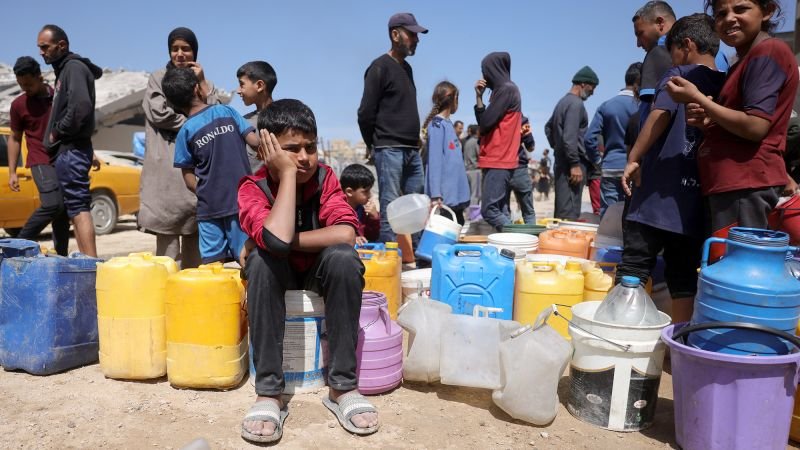CNN
—
International pressure is mounting on Israel amid its renewed military operation in the Gaza strip, as both the United Kingdom and the European Union announced measures distancing themselves from the country on Tuesday.
The United Kingdom paused trade negotiations with Israel and sanctioned West Bank settlers, as Britain’s top diplomat slammed Israel’s operation in Gaza as “morally unjustifiable” and “wholly disproportionate.”
Meanwhile, the European Union announced that it would review its relationship with Israel, with the EU’s foreign policy chief calling the situation on the ground in Gaza “catastrophic.”
The announcements come a day after the UK, France and Canada threatened to take “concrete actions,” including targeted sanctions, if Israel does not halt its fresh offensive and continues to block aid from entering Gaza. On Tuesday, however, the Israeli military vowed to “expand” its operations in the enclave.
Since May 5, Israel has been conducting a new offensive in Gaza, with Prime Minister Benjamin Netanyahu saying on Monday that his country plans to “take control of the entire Gaza Strip.” Hundreds have been killed and an Israeli blockade has meant that no aid entered the strip for 11 weeks until Monday, when five trucks were allowed in – a tiny fraction of the 500 trucks that authorities say are required each day to sustain the population.
British Prime Minister Keir Starmer called the humanitarian situation in Gaza “intolerable” on Tuesday, stressing that aid needs to enter the strip “at pace.”
“The current situation in which we are seeing the bombardment, including of children, and the prospect of starvation, is just intolerable,” Starmer said, adding that “we are coordinating with our allies on this.”
Speaking to lawmakers on Tuesday, British Foreign Secretary David Lammy stressed that the UK backed Israel’s right to defend itself after the Hamas attacks on October 7, 2023, but said the conflict was “entering a dark new phase.”
“For 11 weeks Israeli forces have blockaded Gaza, leaving the World Food Programme without any – any – remaining stocks,” he said. “We are now entering a dark new phase in this conflict. Netanyahu’s government is planning to drive Gazans from their homes into a corner of the strip to the south and permit them a fraction of the aid that they need.”
Israel’s ambassador to the UK, Tzipura Hotovely, was summoned over the Israeli offensive in Gaza, as well as Israeli settler violence and the expansion of Israeli settlements in the occupied West Bank, the British Foreign Office said in a statement.
Settlers are Jewish Israelis who live in the Israeli-occupied territories, mostly in communities built by the Israeli government. Since Hamas’ October 7 attack, settlers have accelerated land grabs in the West Bank with support from the state.
“Settlement approval has accelerated while settler violence has soared,” Lammy told lawmakers Tuesday, announcing fresh sanctions on three individuals and four entities involved in the settler movement, in addition to a round of sanctions last fall.
Lammy added: “We will continue to act against those who are carrying out heinous abuses of human rights.”
Israel’s foreign ministry called the sanctions against the settlers “puzzling, unjustified, and particularly regrettable,” adding that “external pressure will not divert Israel from its path in the fight for its existence and security against enemies seeking its destruction.”
“If, due to anti-Israel obsession and internal political considerations, the British government is willing to harm its own economy — that is its decision,” it said on the UK’s pausing of the trade negotiations.
Shortly after the UK’s announcement, Kaja Kallas, the EU’s foreign policy chief, announced that the bloc would review its association agreement with Israel due to its blockade of humanitarian aid into Gaza.
The EU-Israel Association Agreement covers various forms of cooperation between the two parties, including political dialogue, the free movement of goods, and scientific collaboration.
Article two of the document outlines that “relations between the parties … shall be based on respect for human rights and democratic principles.”
A “strong majority” of EU members voted in favor of a review of article two in the agreement with Israel, Kallas said.
“So, we will launch this exercise,” she said. “In the meantime, it is up to Israel to unblock the humanitarian aid.”
Israel slammed Kallas’ statement, saying it indicates a “misunderstanding of the complex reality Israel is facing.” The foreign ministry accused the EU of “ignoring” an American-backed initiative to send aid to Gaza without it reaching Hamas, and Israel’s decision to facilitate the entry of some aid into the enclave.
“We call on the EU to exert pressure where it belongs — on Hamas,” the Israeli foreign ministry posted to X.
Hundreds of thousands facing starvation
On top of the ongoing military offensive in Gaza, Israel’s monthslong blockade of aid has left one in five people in the enclave facing starvation as the entire territory edges closer to famine, according to the United Nations.
Israel has said that the blockade, along with its new military campaign, is intended to pressure Hamas to release hostages held in the strip. But many international organizations have accused Israel of using starvation as a weapon of war.
Jens Laerke, a spokesperson for the UN humanitarian office, told CNN on Tuesday that is it is “imperative to get supplies into Gaza to save an estimated 14,000 babies likely to suffer from severe acute malnutrition.”
The Israeli military announced Sunday it would allow a “basic amount of food” to enter Gaza as it launched its new major offensive in the strip. The reason, the military said, was the fact that a “starvation crisis” in Gaza would “jeopardize the operation.”
Netanyahu also suggested on Monday that Israel is allowing small amounts of food into the enclave to maintain the support of its international allies.
The Israeli prime minister said that “even our closest allies in the world – US senators I know personally” had told him that they support Israel’s war against Hamas, but “cannot accept… images of mass starvation.”
“We (are) approaching a dangerous point we don’t want to reach,” Netanyahu added.
The leader of Israel’s left-wing Democrats party, retired Israeli general Yair Golan, warned on Tuesday that Israel is “on its way to becoming a pariah state” because of its actions in Gaza.
“A sane country does not wage war against civilians, does not kill babies as a hobby, and does not set itself a goal of expelling a population,” he told Israel’s public news channel Kan News. Netanyahu called Golan’s claim an “outrageous incitement against our heroic soldiers and against the State of Israel.”
On Tuesday, the Israeli military’s Chief of Staff Eyal Zamir vowed that Israel would “expand the maneuver” and “occupy additional territories” in Gaza until Hamas is defeated.
“The IDF operates at all times in accordance with IDF values, the law and international law, while uncompromisingly safeguarding the security of the state of Israel and its citizens. Any statement that casts doubt on the value of our actions and the morality of our fighters is baseless,” Zamir said.
On Monday, five aid trucks entered Gaza, according to the Israeli agency that approves aid shipments into the region, a number that French Foreign Minister Jean-Noel Barrot called “totally insufficient.”
On Tuesday, Israel gave its approval for the UN to send “around 100” trucks into the enclave, according to Laerke.
Laerke said that he hoped that many, if not all, of the aid trucks could cross to a point into Gaza on Tuesday.
“We need to get the supplies in as soon as possible, ideally within the next 48 hours. We will try to reach as many as we can in the days ahead – and are prioritizing baby food on first convoys,” he said.
COGAT, the Israeli agency that approves aid shipments into Gaza, said that 93 UN trucks had crossed into Gaza by Tuesday evening. These trucks carried flour, baby food, and medicine into the strip, according to UN Secretary-General spokesperson Stephane Dujarric.
Though the aid is now in the enclave, it has not yet been distributed, Dujarric said. Israeli security forces have ordered that the trucks need to be unloaded and reloaded before being given permission to be handed over to teams inside Gaza, he explained.
“So just to make it clear, while more supplies have come into the Gaza Strip, we have not been able to secure the arrival of those supplies into our warehouses and delivery points,” Dujarric said.
This story has been updated with developments.
































